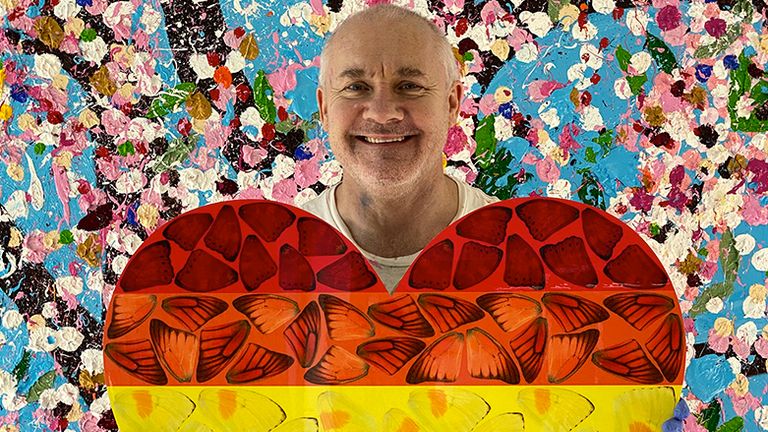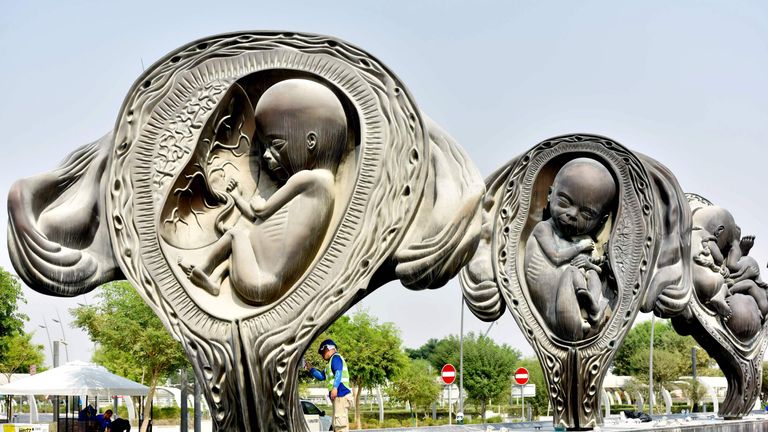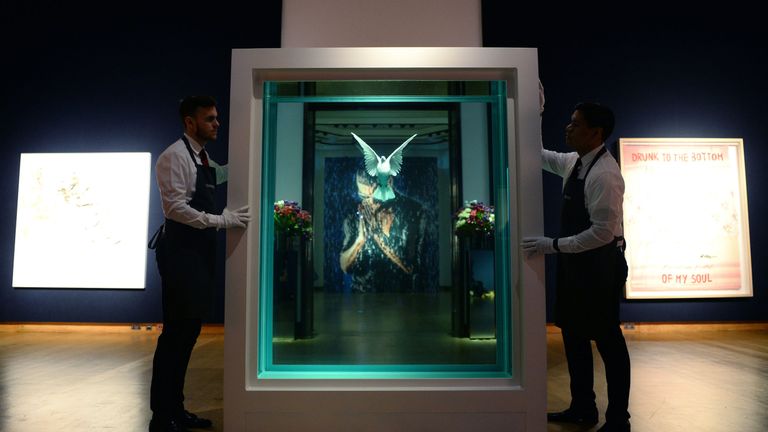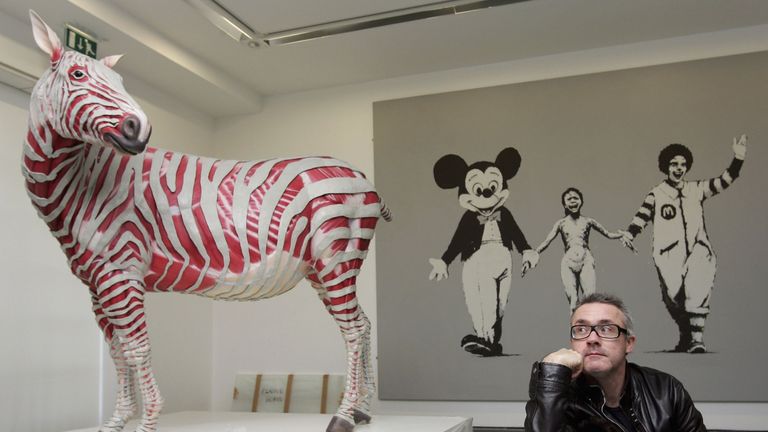Coronavirus: Damien Hirst on art, rainbows and coping with lockdown
Damien Hirst tells Sky News why he wanted to join the kids in making the rainbow pictures displayed in windows across the country.
Wednesday 20 May 2020 15:22, UK
No stranger to accusations of plagiarism, Damien Hirst admits all his ideas are "stolen" and his latest concept is pinched from children. But it's for a good cause.
Like thousands in lockdown, the Turner Prize winner has been painting rainbows - customising them with his famed butterfly wings motif to add meaning and value to the nation's chosen symbol of hope during coronavirus.
The prints, are priced £300 and £1,000, are available to buy until 25 May through the art website Heni Editions, with all proceeds going to NHS Charities Together and The Felix Project (a London surplus food distributor).
The British artist's acclaimed butterflies represent death and resurrection, providing a pertinent and opportune way to give the rainbows a makeover.
Hirst told Sky News: "I saw those kids' paintings of rainbows, you know in windows, and just remember thinking it's times like this you want to think about children. So I thought I just want to make a rainbow as well…
"They're optimistic, they're hopeful and they look great… so I just thought I'd try and help."
The 54-year-old added: "It's nice to think of art as something that can help you know, raising money and raising awareness and helping people, it's great that art has that power.
"Art's… just a hopeful thing, we need it."
Famed for using assistants to produce some of his most famous artworks, including his Spot paintings, Hirst said surprisingly, working alone in lockdown "hasn't been so bad".
"It's amazing how quickly you get used to it.
"I've managed to paint every day. I've got a bit of a routine going... It's a strange world… I just paint really but the paintings are going really well."
However, he admited he has been concerned for his health.
"I was a little bit confused in the beginning, not touching lift buttons and wearing masks and thinking is this really necessary, but… I think I just took it seriously quite quickly because if I get a chest infection, I can never get rid of it so I've been worried. I don't think I'd do well with it."
He's famed as the 'bad boy' of the art world for provocative, conceptual, headline grabbing pieces such as his diamond encrusted platinum skull (For The Love of God created in 2007), 1991's preserved tiger shark, and more recently the Treasures from the Wreck, based on a hoax discovery.
And it's a fame that has reaped monetary rewards. Hirst was ranked 409 in the Sunday Times Rich List with an estimated worth of £315m.
Speaking from his London studio, as frank as ever, Hirst admited for all its power, art is a luxury.
"When these sorts of things are happening in the world, any sort of crisis, I think art can quickly go out the window because it's a leisure activity you know. It's not something that puts food on the table in a direct sense."
It's clear, as he says it, that the irony isn't lost on him.
Hirst would have been about to launch his Cherry Blossoms exhibition in June, but like countless shows across the world it has been pushed back to 2021.
It will make him the first living artist to have a solo museum show in Paris (at the Fondation Cartier contemporary art museum).
As with the Rainbow Editions, Hirst is banking on the idea that people will seek escapism in his new canvas paintings, and still flock to the show when it finally opens in a post-COVID 19 era.
Many films, books and TV series are being re-written in the cold light of the pandemic because they feel suddenly, somehow less relevant and outdated. What does he make of what artists response to the crisis might be?
"It's difficult to say how artists will react to it but I certainly feel more focused and inspired in a time like this.
"There's a great painting that I put on my Instagram by Egon Schiele, a portrait of him and his wife and his wife was six months pregnant and she died of the Spanish flu… and he ended up putting the child in the picture and then he died.
"It's called The Family and you can really feel that… It was a family that never was, that never existed and it's just a great example of art that came out of that crisis of that time.
"It makes you think of all families and everybody and this difficulty and about surviving and caring for people."
On the galleries that face closure as a result of the pandemic and the uncertain future of the arts, Hirst said he has no crystal ball.
:: Listen to the Backstage podcast on Apple Podcasts, Google Podcasts, Spotify, Spreaker
"I think it's the same or for everybody, you can't think too far into the future. Of course, people are worrying about their businesses and they're worried about their personal survival.
"People are thinking, am I gonna survive through this? One thing's for certain, the world's gonna be a very different place afterwards.
"I'm having to look at my business properly and… set up things I never even thought about… but it's too early to tell and too hard to say what things are gonna look like afterwards, but I definitely think that something will change."
On the institutions embracing virtual exhibitions and digital alternatives that some suggest could help democratise the arts, does Hirst believe this crisis could trigger any positive changes in the art world?
"It's just about getting people's attention. Art is on a lot of levels entertainment, and my love of art came out of the Natural History Museum rather than intimidating, posh galleries…
"A great reaction to an artwork for me is 'Wow!' I want people to walk into one of my shows and go 'Wow' and I want them to want to stay there, and virtually people do that in rooms and in the real world they do that in rooms.
"I guess for an artist, the thing that artists are most afraid of is being ignored so if you create a virtual room or an exhibition and no one goes in it then no one's gonna be happy, so I think it's all about how things will work."
The Rainbow Editions are available until midnight on Monday 25 May via art website Heni Editions.








